Baekje
Baekje or Paekche[2] (Korean: 백제; Hanja: 百濟; RR: Baekje, Korean pronunciation: [pɛk̚.t͈ɕe]) was a Korean kingdom located in Southwestern Korea from 18 BC[1] to 660 AD. It was one of the Three Kingdoms of Korea, together with Goguryeo and Silla.
Baekje 백제 (百濟) | |||||||||||||
|---|---|---|---|---|---|---|---|---|---|---|---|---|---|
| 18 BCE–660 CE | |||||||||||||
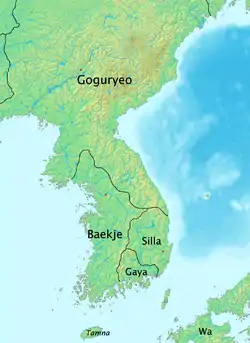 Baekje at its peak in 375 | |||||||||||||
| Capital |
| ||||||||||||
| Common languages | Baekje (Koreanic), Classical Chinese (literary) | ||||||||||||
| Religion | Buddhism, Confucianism, Taoism, Shamanism | ||||||||||||
| Government | Monarchy | ||||||||||||
| King | |||||||||||||
• 18 BCE – 28 CE | Onjo (first) | ||||||||||||
• 346–375 | Geunchogo | ||||||||||||
• 523–554 | Seong | ||||||||||||
• 600–641 | Mu | ||||||||||||
• 641–660 | Uija (last) | ||||||||||||
| Historical era | Ancient | ||||||||||||
• Establishment | 18 BCE | ||||||||||||
• Campaigns of King Geunchogo | 346–375 | ||||||||||||
• Introduction of Buddhism | 385 | ||||||||||||
• Fall of Sabi | 18 July 660 CE | ||||||||||||
| |||||||||||||
| Today part of | North Korea South Korea | ||||||||||||
| Korean name | |
| Hangul | 백제 |
|---|---|
| Hanja | 百濟 |
| Revised Romanization | Baekje |
| McCune–Reischauer | Paekche |
| IPA | [pɛk̚.t͈ɕe] |
Baekje was founded by Onjo, a grandson of Haemosu of Buyeo, the third son of Goguryeo's founder Jumong and So Seo-no, at Wiryeseong (present-day southern Seoul). Royal family Onjo, So seo-no, and Biryu's surname was Buyeo. Baekje, like Goguryeo, claimed to succeed Buyeo, a state established in present-day Manchuria around the time of Gojoseon's fall.
Baekje alternately battled and allied with Goguryeo and Silla as the three kingdoms expanded control over the peninsula. At its peak in the 4th century, Baekje controlled most of the western Korean peninsula, as far north as Pyongyang, and had 22 Damro system over present day Japan, China, South-east Asia.[3]
It held territories in China, such as in Liaoxi, though this view is controversial. It became a significant regional sea power, with political and trade relations with countries in China, island powers in present day Japan, and South-east Asia.
Baekje was a great maritime power;[4] its nautical skill, which made it the Phoenicia of East Asia, was instrumental in the dissemination of Buddhism throughout East Asia and continental culture to Japan.[5][6]
In 660, it was defeated by the Silla and Tang alliance, and was ultimately submitted to Unified Silla.
History
Founding
Baekje is mainly composed of the native Korean Han (Hanja: 韓人) from Mahan and the Koreanic Yemaek (Hanja: 濊貊族) from Buyeo and Gokuryeo. Those from the Lelang Commandery (Korean: Nakrang, Hanja: 樂浪) came in through trade and conquest, and a small number of Jin (Hanja: 辰人) were also admitted into the polities of Baekje.[7]
Baekje was founded in 18 BC[1] by King Onjo, who led a group of people from Goguryeo south to the Han River basin. According to the Chinese Records of the Three Kingdoms, during the Samhan period, one of the chiefdoms of the Mahan confederacy was called already Baekje.
The Samguk Sagi provides a detailed account of Baekje's founding. Jumong had left his son Yuri in Buyeo when he left that kingdom to establish the new kingdom of Goguryeo. Jumong became Divine King Dongmyeong, and had two more sons with So Seo-no, Onjo and Biryu. When Yuri later arrived in Goguryeo, Jumong promptly made him the crown prince. Realizing Yuri would become the next king, So Seo-no left Goguryeo, taking her two sons Biryu and Onjo south to found their own kingdoms with their people, along with ten vassals. She is remembered as a key figure in the founding of both Goguryeo and Baekje.
Onjo settled in Wiryeseong (present-day Hanam), and called his country Sipje (십제, 十濟, meaning "Ten Vassals"), while Biryu settled in Michuhol (present-day Incheon), against the vassals' advice. The salty water and marshes in Michuhol made settlement difficult, while the people of Wiryeseong lived prosperously.
Biryu then went to his brother Onjo, asking for the throne of Sipje. When Onjo refused, Biryu declared war, but lost. In shame, Biryu committed suicide, and his people moved to Wiryeseong, where King Onjo welcomed them and renamed his country Baekje ("Hundred Vassals").
King Onjo moved the capital from the south to the north of the Han river, and then south again, probably all within present Seoul, under pressure from other Mahan states. King Gaeru is believed to have moved the capital north of the river to Bukhansanseong in 132, probably in present-day Goyang to the northwest of Seoul.
Through the early centuries of the Common Era, sometimes called the Proto–Three Kingdoms Period, early Baekje gradually gained control over the other Mahan tribes.
Expansion
The Baekje Kingdom, which belongs to the Mahan confederacy, first integrates the Han River (Korea) basin area, then overthrows Mokji state (목지국, 目支國), the dominant country, and then integrates Mahan as a territorial state.
During the reign of King Goi (234–286), Baekje became a full-fledged kingdom, as it continued consolidating the Mahan confederacy. In 249, according to the ancient Japanese text Nihonshoki, Baekje's expansion reached the Gaya confederacy to its east, around the Nakdong River valley. Baekje is first described in Chinese records as a kingdom in 345. The first diplomatic missions from Baekje reached Japan around 367 (According to the Nihon Shoki : 247).
King Geunchogo (346–375) expanded Baekje's territory to the north through war against Goguryeo, while annexing the remaining Mahan societies in the south. During Geunchogo's reign, the territories of Baekje included most of the western Korean Peninsula (except the two Pyeongan provinces), and in 371, Baekje defeated Goguryeo at Pyongyang. Baekje continued substantial trade with Goguryeo, and actively adopted Chinese culture and technology. Buddhism became the official state religion in 384.
Baekje also became a sea power and continued mutual goodwill relationships with the Japanese rulers of the Kofun period, transmitting continental cultural influences to Japan. The Chinese writing system, Buddhism, advanced pottery, ceremonial burial, and other aspects of culture were introduced by aristocrats, artisans, scholars, and monks throughout their relationship.[8]
During this period, the Han River basin remained the heartland of the country.
Ungjin period
In the 5th century, Baekje retreated under the southward military threat of Goguryeo, and in 475, the Seoul region fell to Goguryeo. Baekje's capital was located at Ungjin (present-day Gongju) from 475 to 538.
Isolated in mountainous terrain, the new capital was secure against the north but also disconnected from the outside world. It was closer to Silla than Wiryeseong had been, however, and a military alliance was forged between Silla and Baekje against Goguryeo.

Most maps of the Three Kingdoms period show Baekje occupying the Chungcheong and Jeolla provinces, the core of the country in the Ungjin and Sabi periods.
Sabi period
In 538, King Seong moved the capital to Sabi (present-day Buyeo County), and rebuilt his kingdom into a strong state. Temporarily, He changes the official name of the country as the Nambuyeo (Korean: 남부여; Hanja: 南扶餘; RR: Nambuyeo, Korean pronunciation: [na̠m.pu.jʌ̹]; lit. "Southern Buyeo"), a reference to Buyeo to which Baekje traced its origins. The Sabi Period witnessed the flowering of Baekje culture, alongside the growth of Buddhism.[9]
Under pressure from Goguryeo to the north and Silla to the east, Seong sought to strengthen Baekje's relationship with China. The location of Sabi, on the navigable Geum River, made contact with China much easier, and both trade and diplomacy flourished during his reign and continuing on into the 7th century.
In the 7th century, with the growing influence of Silla in the southern and central Korean peninsula, Baekje began its decline.
Fall and restoration movement
In 660, the coalition troops of Silla and Tang attacked Baekje, which was then allied with Goguryeo. A heavily outmanned army led by General Gyebaek was defeated in the Battle of Hwangsanbeol near Nonsan. The capital Sabi fell almost immediately thereafter, resulting in the annexation of Baekje by Silla. King Uija and his son Buyeo Yung were sent into exile in China while at least some of the ruling class fled to Japan.
Baekje forces attempted a brief restoration movement but faced Silla–Tang joint forces. A Buddhist monk Dochim (도침, 道琛) and the former Baekje general Buyeo Boksin rose to try to revive Baekje. They welcomed the Baekje prince Buyeo Pung back from Japan to serve as king, with Juryu (주류, 周留, in modern Seocheon County, South Chungcheong) as their headquarters. They put the Tang general Liu Renyuan (劉仁願) under siege in Sabi. Emperor Gaozong sent the general Liu Rengui, who had previously been demoted to commoner rank for offending Li Yifu, with a relief force, and Liu Rengui and Liu Renyuan were able to fight off the Baekje resistance forces' attacks, but were themselves not strong enough to quell the rebellion, and so for some time the armies were in stalemate.
Baekje requested Japanese aid, and King Pung returned to Baekje with a contingent of 5,000 soldiers. Before the ships from Japan arrived, his forces battled a contingent of Tang forces in Ungjin County. In 663, Baekje revival forces and a Japanese naval fleet convened in southern Baekje to confront the Silla forces in the Battle of Baekgang. The Tang dynasty also sent 7,000 soldiers and 170 ships. After five naval confrontations that took place in August 663 at Baekgang, considered the lower reaches of Geum River or Dongjin river, the Silla–Tang forces emerged victorious, and Buyeo Pung escaped to Goguryeo.

| History of Korea |
|---|
 |
| Timeline |
|
|
.jpg.webp)
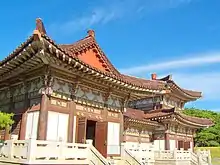
Social and political structure
The establishment of a centralized state in Baekje is usually traced to the reign of King Goi, who may have first established patrilineal succession. Like most monarchies, a great deal of power was held by the aristocracy. King Seong, for example, strengthened royal power, but after he was slain in a disastrous campaign against Silla, the nobles took much of that power away from his son.
The Hae clan and the Jin clan were the representative royal houses who had considerable power from the early period of Baekje, and they produced many queens over several generations. The Hae clan was probably the royal house before the Buyeo clan replaced them, and both clans appear descended from the lineage of Buyeo and Goguryeo. The "Great Eight Families" (Sa, Yeon, Hyeop, Hae, Jin, Guk, Mok, and Baek) were powerful nobles in the Sabi era, recorded in Chinese records such as Tongdian.
Central government officials were divided into sixteen ranks, the six members of the top rank forming a type of cabinet, with the top official being elected every three years. In the Sol rank, the first (Jwapyeong) through the sixth (Naesol) officials were political, administrative, and military commanders. In the Deok rank, the seventh (Jangdeok) through the eleventh (Daedeok) officials may have headed each field. Mundok, Mudok, Jwagun, Jinmu and Geuku from the twelfth to the sixteenth, may have been military administrators.
According to the Samguk Yusa,[10] during the Sabi period, the chief minister (Jaesang) of Baekje was chosen by a unique system. The names of several candidates were placed under a rock (Cheonjeongdae) near Hoamsa temple. After a few days, the rock was moved and the candidate whose name had a certain mark was chosen as the new chief minister. Whether this was a form of selection by lot or a covert selection by the elite is not clear. This Council called Jeongsa Rock Council.
Language and culture
Baekje was established by immigrants from Goguryeo who spoke what could be a Buyeo language, a hypothetical group linking the languages of Gojoseon, Buyeo, Goguryeo, and Baekje. In a case of diglossia, the indigenous Samhan people, having migrated in an earlier wave from the same region, probably spoke a variety of the same language. Kōno Rokurō has argued that the kingdom of Baekje was bilingual, with the gentry speaking a Puyŏ language and the common people a Han language.[11]
proto-Do, Seon(仙思想) ideology stands out in overall Baekje's relics. The magnificent incense burner describe a world of Bak mountain, light mountain where was supposed to think as a root according to legends.
Gaya had a direct linkage with Ayordiya(阿踰陀國) Tamil. Buddhism in Baekje, a religion originating in what is now India, was transmitted to Gokurea, Baekje via China in the late 4th century.[12] The Samguk yusa records the following 3 monks among first to bring the Buddhist teaching, or Dharma, to Korea: Malananta (late 4th century) - an Indian Buddhist monk who brought Buddhism to Baekje in the southern Korean peninsula, Sundo - a Chinese Buddhist monk who brought Buddhism to Goguryeo in northern Korea and Ado monk who brought Buddhism to Silla in central Korea.[13]
Buddhist themes are frequent in Baekje artwork. The beatific Baekje smile found on many Buddhist sculptures expresses the warmth typical of Baekje art.
The tomb of King Muryeong (501–523), was built by buying lands from land gods which is very unique concept that we can assume Baekje people cared for nature. It was made with bricks, and in arch shape. The tomb also contained many funerary objects of the Baekje tradition, such as the gold crown ornaments, gold belts, and gold earrings. Mortuary practices also followed the unique tradition of Baekje. The coffin case was made with the top quality Geumsong(Ko'oyamaki) laquer a specific pine tree only grow in Fukushima and Miyajaki. This tomb is seen as a representative tomb of the Ungjin period.
Delicate lotus designs of the roof-tiles, intricate brick patterns, curves of the pottery style, and flowing and elegant epitaph writing characterize Baekje culture. The Buddhist sculptures and refined pagodas reflect religion-inspired creativity. A splendid gilt-bronze incense burner (백제금동대향로 Baekje Geumdong Daehyeongno) excavated from an ancient Buddhist temple site at Neungsan-ri, Buyeo County, exemplifies Baekje art. Baekje was famous for sophisticated visual arts and architecture technique. A typical Baekje wooden pagoda is one of its legacy. Baekje scholars taught Shotoku taeja of Yamato Hanja, Buddhism, architecture and etc. Baekje refugees contributed to start Asuka culture and later, culture in Nara, Japan. It is interesting the name of Baekje's artisans' built temple Hokoji is written 飛鳥 temple, because it is pronounced 'Bijo' in Korean, and reminds Biryu, brother of the founder Onjo.
Little is known of Baekje music, but Its ensemble is called 'Oaksa' consisting of five musicians with different instruments. They are Wanham, Baeso, Tungso, drum, Baekjegeum(string instrument). Some instrument is the same as ones seen in the West.(Today's Central Asia, Tarim basin, Shinjang Ughur). The local musicians were sent with as diplomatic ambassador to Nam-Jo(South Jo) in the 7th century, indicating that a distinctive musical traditions had developed by that time.
| architecture | music & art | costume | design | Seon(仙思想) idealogy | symbol |
|---|---|---|---|---|---|
_%EC%95%BC%EA%B2%BD.jpg.webp) Miruek(Maitreya) Buddha temple's stone pagoda left in Iksan, Korea |
 5 ensemble, Oaksa |
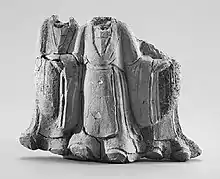 Toyong found in Baekje |
_(30079340202).jpg.webp) Baekje game Baduk |
 Baekje roof tiles that show traditional Korean Seon ideology, mystic Bak mountain and Bonghwang bird on the top |
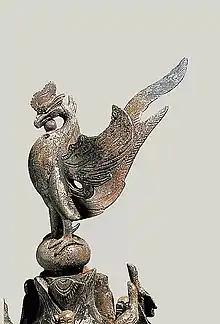 Bonghwang divine bird |
.jpg.webp) model of Baekje's pyramidal mound tomb in Gangnam, Seoul |
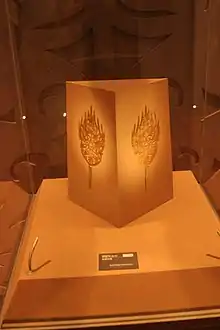 Two Gold diadem ornaments found in King Muryeong's tomb which were for the queen. |
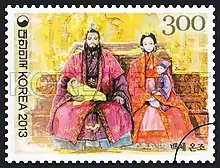 |
 Muryeong tomb's hair accessories |
.jpg.webp) representative repeated Korean motif |
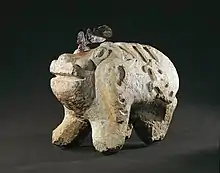 guardian animal that was protecting king and queen Muryeong's tomb. |
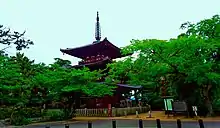 百済寺 Baekjesa (temple) |
-04.jpg.webp) gold crown of Baekje from the museum |
 Matsuri written in a flag king Baekje Myoungshin |
.jpg.webp) laquerware found in Baekje pyramidal tomb |
.jpg.webp) |
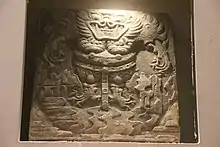 Chiwoocheonwang , or dokebi tile |
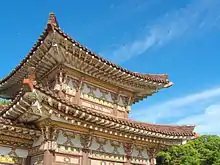 King Dongmyong, Pyongyang, North Korea |
.jpg.webp) Sarira case or urn .jpg.webp) |
_(29555535554).jpg.webp) Wooden clogs of Baekje, worn in rainy day |
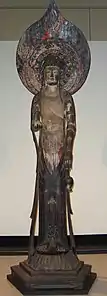 The Kudara Kanon (Baekche Kwaneum) at the Tokyo National Museum. Asuka period (552-650). |
.jpg.webp) lotus tile, and carving on the petal looks like hemps |
| Monarchs of Korea Baekje |
|---|
|
Military
The town leaders and its subjects participated in the military of Baekje on a local level, and was distributed of the loots and captives.The subjects usually worked in the supply division. The post of Jwajang led the military.[14] Geunchogo established the division of central military and local militaries and the people of Baekje usually served the military for 3 years.[14] As Baekje entered the sabi period, the military was divided into the royal private guard, the capital central military and the local military.[14] The royal private guard handled matters such as protecting the palace.[14] The weapons available to the soldiers were diverse.[14]
Archaeology
The first ever bone remains of Baekje people were found in the eungpyeongri tombs in buyeo, which made possible reconstructions of appearances of Baekje people possible, and the tombs seem to have no sign of being looted.[15]
Foreign relations
Relations with China
Baekje had good relations with Yang and the same with other countries that was found in that same region later. It is hard to see past day Yang to today's China. After that, in 372, King Geunchogo gave a gift to the Nam-Jo(Jin Dynasty), located in the basin of the Yangtze River. After the fall of Jin and the establishment of Song Dynasty in 420, Baekje sent envoys seeking cultural goods and technologies.
Baekje sent an envoy to Northern Wei of Northern Dynasties for the first time in 472, and King Gaero asked for military aid to attack Goguryeo. Kings Muryeong and Seong sent envoys to Yang several times, in the picture attached below, It is written the king of Yang admit Yoseo(West from Lio peninsula) and Yodong are Baekje's territory.
Cultural impact and military assistance
.
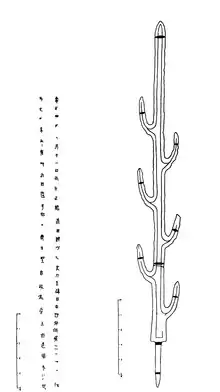
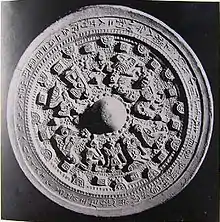
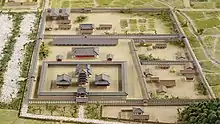
.jpg.webp)
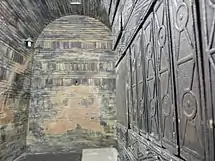

Baekje influenced the formation of the ancient national system of the Waeguk(Japan’s
country name before Yayoi/Yamato) through the spread of culture in various fields. The spread of Buddhism also takes place in this mode of exchange. Beginning with the reign of King Seong of Baekje in the middle of the 6th century, Buddhist culture, including temple construction, flowed into the Japanese archipelago. In the dissemination of temple architectural culture, the elements that can clearly recognize the similarity between Baekje and Waeguk include the form of arrangement of a temple, its construction technology, the technologies and patterns making roof tiles, etc. In the case of Ikaruga in Waeguk, it can be seen that there was a cultural exchange between the Sanggung royal family(Jogu Oke) and the Iksan area of Baekje around 630, judging from the similarity of the palmette lotus design roofend tile and the Buddha statue.[19]
Baekje is believed to have introduced the man'yōgana writing system to Japan, of which the modern hiragana and katakana scripts are descendants.
Kojiki and the Nihon shoki both state this, and though direct evidence is hard to come by, most scholars tend to accept this idea.[20]
To confront the military pressure of Goguryeo to its north and Silla to its east, Baekje (Kudara in Japanese) established close relations with Japan. According to the Korean chronicle Samguk Sagi, Baekje and Silla sent some princes to the Japanese.[21] Whether the princes sent to Japan should be interpreted as diplomats as part of an embassy or literal hostages is debated.[22] the Nihon Shoki, a primary source of material for this relationship, is a compilation of myth, makes it difficult to evaluate. The Samguk Sagi, which also documents this, can also be interpreted in various ways and at any rate it was rewritten in the 13th century, easily seven or eight centuries after these particular events took place. Adding to the confusion is the discovery (in Japan) that the "Inariyama sword, as well as some other swords discovered in Japan, utilized the Korean 'Idu' system of writing". The swords "originated in Paekche and that the kings named in their inscriptions represent Paekche kings rather than Japanese kings".[22] The techniques for making these swords were the apparently similar to styles from Korea, specifically from Baekje.[23][24]
Other historians, such as those who collaborated on 'Paekche of Korea and the Origin of Yamato Japan' and Jonathan W. Best, who helped translate what was left of the Baekje annals,[25] have noted that these princes set up schools in Yamato Japan and took control of the Japanese naval forces during the war with Goguryeo, taking this as evidence of them being more along the lines of diplomats with some kind of familial tie to the Japanese imperial family and as evidence against any hostage status.
As is with many long-past histories and competing records, very little can be definitively concluded. Further research has been difficult, in part due to the 1976 restriction on the study of royal tombs in Japan (to include tombs such as the Gosashi tomb, which is allegedly the resting place of Empress Jingū). Prior to 1976, foreign researchers did have access, and some found Korean artifacts in Japanese dig sites. Recently in 2008, Japan has allowed controlled limited access to foreign archaeologists, but the international community still has many unanswered questions. National Geographic has written that Japan "the agency has kept access to the tombs restricted, prompting rumors that officials fear excavation would reveal bloodline links between the "pure" imperial family and Korea—or that some tombs hold no royal remains at all."[26]
In any case, these Koreans, diplomats and royal relatives or not, brought to Japan knowledge of the Hanja/Kanji writing system, Buddhism, architecture, iron processing for weapons, and various other technologies.[27][28] In exchange, Japan provided military support.[29]
According to mythical accounts in the controversial Nihon Shoki, Empress Jingū extracted tribute and pledges of allegiance from the kings of Baekje, Silla, and Goguryeo. At the height of Japanese nationalism in the early 20th century, Japanese historians used these mythical accounts along with a passage in the Gwanggaeto Stele to establish ideological rationale to the imperialist outcry for invasion of Korea.[30][31] Other historians have pointed out that there is no evidence of this Japanese account in any part of Korea, in addition to not being in any viable text in China or Korea.[32][33] Regarding the Gwanggaeto Stele, because the lack of syntax and punctuation the text can be interpreted 4 different ways,[22][34] one which states that Korea crossed the water and subjugated Wae. Due to this problem in interpretation, nothing can be concluded. Also complicating the matter is that in the Nihongi a Korean named Amenohiboko is described in Nihon Shoki as a maternal predecessor of
Tajima-no-morosuku (但馬諸助),[35] This is highly inconsistent and difficult to interpret correctly.
Scholars believe that the Nihon Shoki gives the invasion date of Silla and Baekje as the late 4th century. However, by this time, Japan was a confederation of local tribes without sophisticated iron weapons, while the Three Kingdoms of Korea were fully developed centralized powers with modern iron weapons and were already utilizing horses for warfare. It is very unlikely that a developing state such as Yamato had the capacity to cross the sea and engage in battles with Baekje and Silla.[30][36][37] The Nihon Shoki is widely regarded to be an unreliable and biased source of information on early relations with Korea, as it mixes heavy amounts of supposition and legend with facts.[38][39][40]
Some Japanese scholars interpret the Gwanggaeto Stele, erected in 414 by King Jangsu of Goguryeo, as describing a Wae's invasion in the southern portion of the Korean peninsula. However, Mohan claims that Goguryeo fabricated the Japanese invasion in order to justify its conquest of Baekje.[30] If this stele was a dedication to a Korean king, it can be argued that it would logically highlight Korea's conquests and not dedicate it to a strange incident regarding Japan. In any case, because of these various possible interpretations, the circumstances surrounding the stele are still highly debated and inconclusive.
Chinese scholars participated in the study of the Stele during the 1980s. Wang Jianqun interviewed local farmers and decided that no intentional fabrication occurred, adding that the lime on the Stele was pasted by local copy-making workers to enhance readability.[41] Xu Jianxin of the Chinese Academy of Social Sciences discovered the earliest rubbed copy which was made before 1881. He also concluded that there was no evidence the Japanese had intentionally damaged any of the characters on the Stele.[42]
Today, most Chinese and Japanese scholars contradict the conspiracy theories, based on the study of the Stele itself and advocate Japanese intervention in the era,[42][43][44] although its size and effect are disputed.
In the project of writing a common history textbook, Kim Tae-sik of Hongik University (Korea) denied Japan's theory.[45] But, Kōsaku Hamada of Kyushu University (Japan) reported their interpretations of the Gwanggaeto Stele text, neither of them adopting the intentionally damaged stele theory in their interpretations.[46]
The fall of Baekje and the military support from Japan
Some members of the Baekje nobility and royalty emigrated to Japan even before the kingdom was overthrown. In response to Baekje's request, Japan in 663 sent the general Abe no Hirafu with 20,000 troops and 1,000 ships to revive Baekje with Buyeo Pung (known in Japanese as Hōshō), a son of king Uija of Baekje who had been an emissary to Japan. Around August 661, 10,000 soldiers and 170 ships, led by Abe no Hirafu, arrived. Additional Japanese reinforcement, including 27,000 soldiers led by Kamitsukeno no Kimi Wakako (上毛野君稚子) and 10,000 soldiers led by Iohara no Kimi (廬原君) also arrived at Baekje in 662.
This attempt, however, failed at the Battle of Baekgang, and the prince escaped to Goguryeo. According to the Nihon Shoki, 400 Japanese ships were lost in the battles. Only half of the troops were able to return to Japan.
The Japanese army retreated to Japan with many Baekje refugees. The former royal family members were initially treated as "foreign guests" (蕃客) and were not incorporated into the political system of Japan for some time. Buyeo Pung's younger brother Seon'gwang (Zenkō in Japanese) (善光 or 禅広) used the family name Kudara no Konikishi ("King of Baekje") (百濟王) (they are also called the Kudara clan, as Baekje was called Kudara in Japanese).
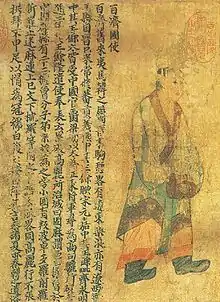
Legacy
Baekje was briefly revived in the Later Three Kingdoms of Korea period, as Unified Silla collapsed. In 892, General Gyeon Hwon established Hubaekje (“Later Baekje”), based in Wansan (present-day Jeonju). Hubaekje was overthrown in 936 by King Taejo of Goryeo.
In contemporary South Korea, Baekje relics are often symbolic of the local cultures of the southwest, especially in Chungnam and Jeolla. The gilt-bronze incense burner, for example, is a key symbol of Buyeo County, and the Baekje-era Buddhist rock sculpture of Seosan Maaesamjonbulsang is an important symbol of Seosan City.
On 17 April 2009, Ōuchi Kimio (大內公夫) of Ōuchi clan visited Iksan, Korea to pay tribute to his Baekje ancestors. The Ōuchi are descendants of Prince Imseong.[47]
In 2010, Baekje Cultural Land was opened to visitors. The theme park aims to preserve Baekje architecture and culture.[48]
Baekje Historic Areas, which feature locations with remains of the period, was designated a UNESCO World Heritage site in 2015.[49]
See also
- Crown of Baekje
- List of Baekje people
- List of Baekje monarchs
Notes
- "Korea, 1–500 A.D.". In Heilbrunn Timeline of Art History. New York: The Metropolitan Museum of Art, 2000–. Korea, 1–500 A.D. at the Wayback Machine (archived 2015-11-14) (October 2000)
- "Paekche". Encyclopædia Britannica.
- 《Yang양서》(梁書), 《North history》 -Baekje-. pp. 號所治城曰固麻謂邑擔魯 如中國之言郡縣也 其國有二十二擔魯 皆以子弟宗族分據之 Baekje call their castle 'Goma' and controlling states 'Damro'. This is same as provinces in China. In that country, there are 22 damros, all are ruled by sons of root ancestral ethnicity. (백제는) 도성을 고마라고 부르며 속읍을 담로라고 부르는데, 이는 중국의 군현제와 같은 것이다. 그 나라에는 22개의 담로가 있는데, 모두 왕의 자제와 종족으로 하여금 다스리게 하였다.
- Ebrey, Patricia Buckley; Walthall, Anne; Palais, James B. (2006). East Asia: A Cultural, Social, and Political History. Houghton Mifflin. p. 123. ISBN 9780618133840. Retrieved 12 September 2016.
- Kitagawa, Joseph (2013-09-05). The Religious Traditions of Asia: Religion, History, and Culture. Routledge. p. 348. ISBN 9781136875908. Archived from the original on 3 December 2016. Retrieved 29 July 2016.
- Ebrey, Patricia Buckley; Walthall, Anne; Palais, James B. (2013). East Asia: A Cultural, Social, and Political History, Volume I: To 1800. Cengage Learning. p. 104. ISBN 978-1111808150. Archived from the original on 3 December 2016. Retrieved 12 September 2016.
- Chinese Han(漢) and Korean Han(韓) is different
- "Korean Buddhism Basis of Japanese Buddhism Archived 2016-03-03 at the Wayback Machine," Seoul Times, June 18, 2006; "Buddhist Art of Korea & Japan Archived 2016-03-03 at the Wayback Machine," Asia Society Museum; "Kanji Archived 2012-05-10 at the Wayback Machine," JapanGuide.com; "Pottery Archived 2009-10-29 at the Wayback Machine," MSN Encarta; 2009-10-31.
- Il-yeon: Samguk Yusa: Legends and History of the Three Kingdoms of Ancient Korea, translated by Tae-Hung Ha and Grafton K. Mintz. Book Two, page 119. Silk Pagoda (2006). ISBN 1-59654-348-5
- Il-yeon: Samguk Yusa: Legends and History of the Three Kingdoms of Ancient Korea, translated by Tae-Hung Ha and Grafton K. Mintz. Book Two, page 121. Silk Pagoda (2006). ISBN 1-59654-348-5
- Lee, Ki-Moon; Ramsey, S. Robert (2011), A History of the Korean Language, Cambridge University Press, ISBN 978-1-139-49448-9.
- www.metmuseum.org http://www.metmuseum.org/explore/Korea/koreaonline/IntroSculpture.htm. Retrieved 2021-01-18.
{{cite web}}: Missing or empty|title=(help) - "Malananta bring Buddhism to Baekje" in Samguk Yusa III, Ha & Mintz translation, pp. 178-179.
- "백제". Encyclopedia of Korean Culture.
- "백제인 얼굴 복원될까…희귀한 백제 인골이 나왔다". www.hani.co.kr. 2021-07-02.
- 聖冏抄 ... 故威德王恋慕父王状所造顕之尊像 即救世観音像是也
- Evelyn McCune. The arts of Korea: an illustrated history. C. E. Tuttle Co., 1962
- Asiatic Society of Japan. Transactions of the Asiatic Society of Japan. The Society, 1986
- Yim(Lim), Jongseo (August 2021). "About the propagation of Baekje's temple architecture to Asuka : focusing on Iksan area". Yonsei university graduate school of education.
{{cite journal}}: Cite journal requires|journal=(help) - Bentley, John R. (2001). "The origin of man'yōgana". Bulletin of the School of Oriental and African Studies. 64 (1): 59–73. doi:10.1017/S0041977X01000040. ISSN 0041-977X. S2CID 162540119.
- Samguk Sagi (in Korean). Archived from the original on 2008-05-12.
六年 夏五月 王與倭國結好 以太子腆支爲質
- Hong Wontack 1994 Paekche of Korea and the origin of Yamato Japan Archived 2016-03-29 at the Wayback Machine, Seoul Kadura International
- 5000 Years of Korean Martial Arts
- Korean Impact (1984)
- Best JW 2007 A History of the Early Korean Kingdom of Paekche, together with an annotated translation of The Paekche Annals of the Samguk sagi (Harvard East Asian Monographs) Massachusetts, Harvard University, Asia studies
- "Japanese Royal Tomb Opened to Scholars for First Time". News.nationalgeographic.com. 2010-10-28. Archived from the original on 2014-09-14. Retrieved 2012-06-10.
- "Korean Buddhism Basis of Japanese Buddhism Archived 2016-03-03 at the Wayback Machine," Seoul Times, June 18, 2006; "Buddhist Art of Korea & Japan Archived 2016-03-03 at the Wayback Machine," Asia Society Museum; "Kanji Archived 2012-05-10 at the Wayback Machine,"
- JapanGuide.com; "Pottery Archived 2009-10-29 at the Wayback Machine," MSN Encarta; "History of Japan Archived 2016-03-04 at the Wayback Machine," JapanVisitor.com. Archived 2009-10-31.
- Delmer M. Brown, ed. (1993). The Cambridge History of Japan. Cambridge University Press. pp. 140–141. ISBN 9780521223522.
- Mohan, Pankaj N. "Rescuing a Stone from Nationalism: A Fresh Look at the Kwanggaeto Stele of Koguryo." Journal of Inner and East Asian Studies, 1 (2004): 89–115.
- 'Gina L. Barnes', "State Formation in Korea", 2001 Curzon Press
- Lee (1997:31–35)
- Kōzō (1997:308–310)
- Coval, Dr John Carter and Alan, 1984, "Korean impact on Japanese culture: Japan's hidden History" Hollym International Corp., Elizabeth, New Jersey
- "Nihon Shoki Vol.6" "昔有一人 乘艇而泊于但馬國 因問曰 汝何國人也 對曰 新羅王子 名曰 天日槍 則留于但馬 娶其國前津耳女 一云 前津見 一云 太耳 麻拖能烏 生 但馬諸助 是清彥之祖父也"
- Grayson, James. "Mimana, A Problem in Korean Historiography," Korea Journal, 17 (1977):65–69.
- 'John Whitney Hall', "Cambridge History of Japan", 1988 Cambridge University Press
- Lee, Hui Jin: 거짓과 오만의 역사, Random house Joongang,2001. ISBN 89-8457-059-1
- 'Boia et al.', "Great Historians from Antiquity to 1800: An International Dictionary", 1989 Greenwood press
- 'William Wayne Farris', "Population, Disease, and Land in Early Japan, 645-900", 1995 Harvard University Asia Center
- 好太王碑研究, 王健群, 1984, 吉林人民
- Xu, Jianxin. 好太王碑拓本の研究 (An Investigation of Rubbings from the Stele of Haotai Wang). Tokyodo Shuppan, 2006. ISBN 978-4-490-20569-5.
- Takeda, Yukio, "Studies on the King Gwanggaeto Inscription and Their Basis" Memoirs of the Research Department of the Toyo Bunko. 47(1989):57-87.
- Oh, Byung-sang (October 4, 2002). "FOUNTAIN: Echoes of drumming hoofbeats". Joongangdaily.joins.com. Archived from the original on November 23, 2007. Retrieved October 17, 2007.
- Kim, Tae-Sik (2005). "Korean-Japanese Relationships in 4th Century; based on Wa Troops Issues in Gwanggaeto Stele" (PDF). The Japan-Korea Cultural Foundation. Archived from the original (PDF) on 2008-10-30.
- Kōsaku, Hamada (2005). 4 世紀の日韓関係 [Japanese-Korean Relationships in 4th Century] (PDF). The Japan-Korea Cultural Foundation. Archived from the original (PDF) on 2008-10-30. Retrieved 2008-08-26.
- 야후! 검색 - 통합 검색. Kr.news.yahoo.com. Retrieved on 2013-07-12. Archived 2011-06-14 at the Wayback Machine
- "Baekje Cultural Land". Chungnam.go.kr. Archived from the original on 2017-05-10. Retrieved 2016-08-30.
- "Baekje Historic Areas". UNESCO Organization. Archived from the original on 8 December 2015. Retrieved 29 November 2015.
Further reading
- Best, Jonathan W. A History of the Early Korean Kingdom of Paekche, together with an annotated translation of "The Paekche Annals" of the "Samguk sagi" (Harvard East Asian Monographs, 2007).
External links
 Media related to Baekje Kingdom at Wikimedia Commons
Media related to Baekje Kingdom at Wikimedia Commons- Baekje History & Culture Hall maintained by South Chungcheong Province of South Korea
- Buyeo National Museum
- Gongju National Museum
